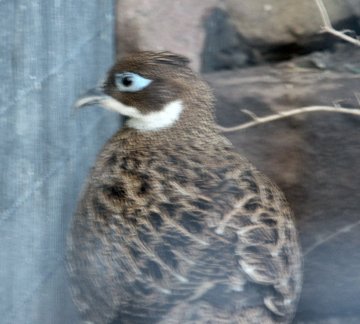In the summer they live in grass and rock covered meadows.
In the winter they prefer coniferous, and mixed forests.
Physical Description:
The males of this species look quite different from the females of the
species. The male Himalayan Monals have bright and colorful feathers of
blue, green, purple, and red. They have a white patch of feathers
underneath the base of their tail, but the rest of their underside is
black. The males also have a crest on top of their heads. Both the male
and female of the species have blue circles of skin around their eyes.
The females and the chicks have an overall brown appearance. Their
feathers also have white and black strips on certain parts. The females
have a white throat. The male chicks resemble the females chicks until
a little after a year when they begin to become more colorful. Before
then you could tell the young male and females apart because of their
larger size and black feathers on the chest in place of the white.
Social Organization::
In captivity these birds are usually kept in pairs of male and females.
Sometimes they are kept in groups of three. The birds may be separated
in the winter from the other sex. The males use loud caling to sow
ehere they are daily at least.Locations of individual males are
apparently advertised by loud daily calling. The males generally
hang out in groups of two to three, but in the springtime they are a
little more territorial. In the winter it is common for females to stay
in groups of about twenty. SOmetimes there may even be a male or two
that has joined one of these groups. The females are considered to be
rather friendly, and the males generaly only show aggression in the
mating season.
Special Adaptations:
Their are sharp edges on the bird's mandible that are important
in cutting and splitting plants that are very tough. The birds forage
with their shovel-like beaks, sometimes digging holes as deep as a
foot. They do this instead of using their feet as some other birds.
The picture of the bird on the right is a female monal. You can distinguish between the males and females by looing at her plumage. The female has blue arounf her eyes but, is a brownish color overall.>

Reproductive Behavior:
The Himalayan Monals begin nesting in may generally. The eggs of the
birds have been observed anywhere from the end of April, until the end
of June. The female generally lays four to five eggs. This
species to be polygynous, but their may be a pair bond sometimes which
lasts from mating to incubation.
The Animal at the Zoo:
The Himalayan Monal I observed at the zoo was a female. She was by
herself in a cage,
she did not seem to be very active. The bird was sitting down and
cleaning its feathers.
Page Author:
April St. John-Alexander apeanu@aol.com
Sources and Links:
1. http://www.gbwf.org/pheasants/monal.html
gbwf.org Copyright 1997-2003
Dan Cowell, webmaster@gbwf.org
2. http://www.feathersite.com/Poultry/NDG/Pheas/
BRKImpeyan.html
All text ©FeatherSite unless otherwise credited; for graphics
see note Barry at featherside@cyborganic.net
3. http://www.wildlifeofpakistan.com/Himalayan_
Monal.htm
Copyright 2001-Wildlife of Paistan-
Pheasants of Pakistan